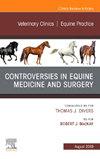肌肉康复技术与损伤预防。
IF 1.1
3区 农林科学
Q3 VETERINARY SCIENCES
Veterinary Clinics of North America-Equine Practice
Pub Date : 2025-01-08
DOI:10.1016/j.cveq.2024.11.010
引用次数: 0
摘要
肌肉损伤后的康复是恢复马运动员的全部功能的关键。康复方案应根据每位患者的整体功能评估量身定制,考虑到特定的运动需求、恢复运动能力的目标和总体预后。康复方案通常旨在调节疼痛,增强修复,改善本体感觉,增加柔韧性,恢复肌肉力量,关节活动范围和神经运动控制。本文将回顾肌肉损伤的机制,肌肉损伤后康复期间常用的各种物理方式,以及损伤预防。本文章由计算机程序翻译,如有差异,请以英文原文为准。
Muscle Rehabilitation Techniques and Prevention of Injury
求助全文
通过发布文献求助,成功后即可免费获取论文全文。
去求助
来源期刊
CiteScore
2.10
自引率
9.10%
发文量
55
审稿时长
>36 weeks
期刊介绍:
Veterinary Clinics of North America: Equine Practice presents those in the veterinary medicine field with the most current treatment of horses, updates on the latest advances, and provides a sound basis for choosing treatment options. Published 3 times a year—in April, August, and December—each issue features expert, state-of-the-art reviews on a single topic in equine practice, including gastroenterology, imaging, infectious diseases, nutrition, orthopedics, pathology, pharmacology and therapeutics, and surgery.

 求助内容:
求助内容: 应助结果提醒方式:
应助结果提醒方式:


